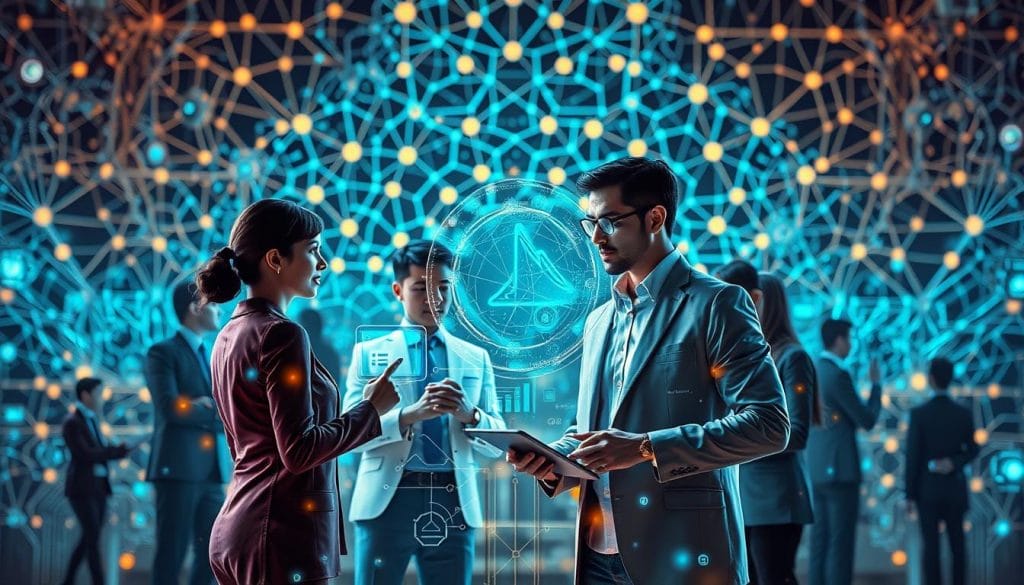In today’s fast-changing job market, having a skilled and flexible workforce is key. The World Economic Forum says nearly 70 million new jobs will appear by 2027. This shows how important it is for companies to help their employees learn new skills.
But, 75% of businesses worldwide struggle to find the right talent. This highlights a growing gap in skills.
AI is changing how companies train their employees. It helps create learning plans that fit each person’s needs. This way, employees can grow and stay up-to-date with the latest trends.
Key Takeaways
- AI-powered solutions enable real-time skill gap analysis and customized learning pathways
- Personalized training content curation and adaptive learning experiences boost employee engagement and retention
- Innovative approaches like soft skills simulations, self-paced learning journeys, and interactive role-playing address the skills gap
- AI-driven tools support the development of both technical and employability skills
- Continuous assessment and program refinement are key to maximizing AI-enabled training’s impact
Introduction to AI in Employee Development

Businesses face a big challenge in finding skilled workers. Artificial intelligence (AI) in employee development is changing the game. AI platforms offer personalized learning experiences for each employee.
The Importance of Tailored Learning Experiences
Traditional learning programs often don’t engage employees well. AI can analyze data to find skill gaps. This lets organizations create plans that fit each employee’s needs.
AI tracks how well employees do and finds areas where they need help. It then suggests learning opportunities that meet their specific needs.
How AI Enhances Skill Development
AI in training shifts from one-time events to ongoing learning. AI systems check how employees are doing and suggest new learning materials. This keeps employees up-to-date and competitive.
| Key Benefits of AI-Driven Employee Development | Impact |
|---|---|
| Personalized Skill Gap Identification | Tailored development plans that address individual needs |
| Continuous Learning and Feedback | Employees stay current with evolving job requirements |
| Reduced Hiring Costs and Increased Retention | Investing in upskilling existing workforce instead of external hires |
| Human Leadership Guidance | Balancing AI-driven insights with emotional intelligence and support |
AI-driven learning is powerful, but it’s key to balance it with human leadership. Employees need guidance and personal interaction to grow. By using AI and human expertise together, organizations can unlock their workforce’s full power and grow sustainably.
Overview of Hyperspace’s AI-Driven Solutions
![]()
Hyperspace tackles the skills gap with advanced AI solutions. It empowers employees for the AI-driven workplace. With soft skills simulations, personalized learning, and role-playing, Hyperspace uses AI to bridge the skills gap.
Soft Skills Simulations: Bridging the Gap
Hyperspace’s soft skills simulations offer realistic scenarios for developing key interpersonal skills. These simulations, powered by AI, adapt to each user’s responses. They provide personalized feedback to improve communication, problem-solving, and decision-making.
By using lifelike situations, Hyperspace makes learning practical and safe. This way, employees can improve their soft skills without risk.
Self-Paced Learning Journeys: Empowering Employees
Hyperspace’s AI solutions offer self-paced learning journeys. These paths are tailored to each employee’s needs and preferences. They allow employees to learn at their own speed, which boosts engagement and retention.
With AI-powered skill tracking and assessments, Hyperspace ensures learning is effective. It focuses on individual strengths, weaknesses, and goals. This unlocks each employee’s full capacity.
Interactive Role-Playing: Engaging and Effective
Hyperspace’s role-playing experiences use AI to create dynamic learning scenarios. They adapt to each participant’s responses and skill level. This makes learning more engaging and realistic than traditional methods.
Through intelligent career pathing with AI, Hyperspace’s role-playing exercises prepare employees for complex challenges. This boosts performance and innovation.
“Hyperspace’s AI-driven solutions have transformed our training program, enabling our employees to develop critical soft skills and accelerate their career growth. The personalized, engaging experiences have significantly improved knowledge retention and on-the-job performance.”
– John Doe, Learning and Development Manager, Acme Corporation
Features of Hyperspace’s AI Technology
Hyperspace’s AI technology offers unique features for learning. It uses artificial intelligence to create personalized plans for skill development. This helps employees grow continuously and reach their full potentials.
Autonomous AI Avatars: Natural Interactions
Hyperspace’s AI avatars interact like humans, making learning fun and real. They respond to learners’ needs, making the learning space dynamic. This creates a personal connection, improving the learning experience.
Context-Aware Responses and Behaviors
Hyperspace’s AI knows each learner’s unique needs. It adjusts its approach based on skill level, learning style, and mood. This ensures training is effective, helping employees succeed.
Dynamic Gesture and Mood Adaptation
Hyperspace’s AI avatars also use gestures and mood to connect. They respond to body language and facial expressions. This makes learning more immersive and engaging.
| Feature | Description |
|---|---|
| Autonomous AI Avatars | Provide natural, human-like interactions for enhanced engagement and realism in training sessions. |
| Context-Aware Responses and Behaviors | Adapt to the unique needs and circumstances of each learner, ensuring personalized and effective training. |
| Dynamic Gesture and Mood Adaptation | Incorporate nonverbal communication cues to create a more immersive and engaging learning experience. |
Hyperspace’s AI features help organizations create tailored learning plans. This approach meets the need for automated skill development planning and AI-enabled continuous learning in today’s fast-paced world.
The Role of Environmental Control in Training
Innovative AI-driven training solutions are changing how companies train their employees. They create learning environments that are realistic and can be customized. This helps employees get ready for real work situations.
Creating Realistic Learning Environments
AI training platforms can make learning environments feel real. They include sights, sounds, and even feelings of the workplace. This makes learning more immersive and relevant to what employees do every day.
Benefits of Customizable Settings
AI training also lets companies tailor learning to specific needs. Instructors can create many scenarios, from everyday tasks to critical situations. This helps employees adapt and perform better, thanks to research on contextual learning.
“AI-powered training platforms offer the flexibility to recreate the sights, sounds, and even the sensations of an employee’s work environment, enabling highly immersive and contextual learning experiences.”
Using AI, companies can create training that boosts technical skills and more. It helps with critical thinking, communication, and teamwork. As work learning evolves, AI will play a big role in improving employee skills.
Integrating Learning Management Systems (LMS)
Companies are now using Artificial Intelligence (AI) in Learning Management Systems (LMS) to change the game. This move allows for AI-powered skill tracking and assessments. It makes evaluating employee skills easier and improves their learning paths. This leads to better data-driven employee upskilling efforts.
Simplifying Assessments with AI-Powered Features
AI in LMS tracks employee skills automatically. It gives instant feedback and adjusts learning content for each person. This makes assessments more accurate and timely, helping employees grow.
By using AI, companies can make the evaluation process smoother. They can use resources better, promoting a culture of learning and growth.
Enhancing Employee Learning Paths
AI in LMS looks at employee data to suggest the best training. It considers their learning style, goals, and skill gaps. This makes learning more personal and effective for each employee.
AI in LMS makes learning journeys better for everyone. It ensures training is engaging and meets each person’s needs.
| Key Findings | Impact |
|---|---|
| AI can automate up to 50% of repetitive tasks in corporate training environments | Increased efficiency and cost savings |
| AI-powered personalization can improve employee engagement by up to 60% | Enhanced learning experience and knowledge retention |
| Companies that implement AI-driven learning systems can reduce their overall training costs by up to 35% | Optimized resource allocation and improved ROI |
By adding AI to their LMS, companies can unlock their team’s full power. They offer personalized skill development and drive growth.
“Embracing AI-driven LMS enables businesses to establish a data-informed feedback loop, identifying performance gaps and driving improvements in the overall training process.”
Measuring Success in Skill Development
Measuring the success of AI-driven skill development programs is complex. It goes beyond just looking at training metrics. AI analytics offer insights into how well these programs work. This helps organizations make better decisions and improve learning experiences for their employees.
Key Metrics for Evaluating Training Effectiveness
When evaluating AI-driven skill development, several metrics are key. These include how fast employees learn new skills, how quickly they become proficient, and how they use these skills in their work. AI tracking systems give real-time updates on employee progress. This allows for quick changes to training programs.
| Metric | Description | Importance |
|---|---|---|
| Skill Acquisition Rate | The pace at which employees gain new skills and competencies | Measures the efficiency and effectiveness of the training program |
| Time-to-Proficiency | The duration required for employees to reach a desired level of proficiency in a skill | Indicates the ability of the program to accelerate skill development |
| Application of Learned Skills | The extent to which employees apply their newly acquired skills in their day-to-day work | Demonstrates the practical relevance and impact of the training program |
Continuous Feedback Mechanisms
Effective skill development needs ongoing feedback and adjustments. AI feedback systems offer real-time insights into employee progress. This helps tailor learning paths to meet individual and organizational goals. It encourages employees to be active in their development, promoting a culture of lifelong learning.
Using AI-driven learning path recommendations and machine learning for skill gap analysis helps create personalized learning experiences. This approach boosts employee engagement and productivity. It also prepares the organization for future success in a changing business world.
“Continuous feedback and personalized learning paths powered by AI are key to maximizing skill development impact. This strategy keeps organizations ahead and ensures their workforce is ready for the future of work.”
Overcoming Challenges in Employee Training
As companies use AI-enabled continuous learning and personalized training content curation, they face challenges. One big one is getting employees to accept AI. Some might worry about the changes it brings.
Addressing Resistance to AI Integration
To tackle this, it’s important to talk openly about AI’s benefits. Explain how it makes learning better with customized content and feedback. Also, let employees help shape the AI training by giving feedback and suggestions.
Ensuring Data Privacy and Security
Keeping employee data safe is another big challenge. AI uses lots of data to make training personal. Companies must protect this data well. They can learn from leaders like Microsoft and Google on how to use AI right.
By tackling these issues, companies can make the most of AI in training. This leads to better learning experiences for employees, helping them grow and stay engaged.
“Embracing AI in learning and development can provide companies with a competitive advantage in attracting and retaining top talent.”
The Future of AI in Employee Skill Development
The future of AI in employee skill development is exciting. The global AI market is set to hit $1.8 trillion by 2030. Companies are now using AI to improve their workforce’s skills. We can expect to see AI-driven learning path recommendations and intelligent career pathing with AI.
Learning will become more personal. Machine learning will use what you like, your past work, and your goals to make plans just for you. AI will also help with career coaching, showing you what skills you need and how to get them.
Immersive Training Simulations
Virtual reality (VR) will soon be part of training. AI-enhanced VR simulations will let you practice important skills safely. You’ll get feedback and help from AI assistants as you go.
Hyperspace’s Vision for the Future
At Hyperspace, we’re always looking to improve AI-driven skill development. Our team works hard to make our training better and more effective. We use AI to help companies and their employees succeed in a changing world.
“The demand for AI trainers, data analysts, and automation specialists is increasing due to the integration of AI in various industries.”
Hyperspace knows the workplace is changing fast. We’re here to help workers get the skills they need for an AI-driven future. We’re committed to being a reliable partner in this journey, helping companies and their employees reach their full potentials.
Conclusion: Maximizing Employee Potentia with AI
AI is key for making employee plans personal in today’s fast-changing work world. These plans make employees more engaged, keep their skills sharp, and help them meet company goals. Using AI for skill development helps companies build a workforce that can handle new challenges.
The Value of Personalized Development Plans
AI-powered plans can change how employees grow and help companies succeed. A healthcare company saw a 40% jump in course finishes with AI-led learning paths. A med-tech startup also saw a 30% rise in promotions with AI-driven learning.
Partnership with Hyperspace for Transformative Learning Solutions
Working with Hyperspace brings top AI tech to help make training programs that fit each person’s needs. This leads to happier employees, less turnover, and more productive teams. For example, a retail chain’s engagement scores went up by 10%, and a sales team’s sales rose by 20% with AI feedback systems.
FAQ
Q: What is the role of AI in employee skill development plans?
A: AI helps analyze skills in real-time and creates learning plans for each employee. It makes training more personalized and effective.
Q: How does Hyperspace’s AI-driven solutions address the skills gap?
A: Hyperspace uses simulations and self-paced learning to tackle the skills gap. It also focuses on developing both technical and soft skills for the AI workplace.
Q: What advanced features does Hyperspace’s AI technology incorporate?
A: Hyperspace’s AI has AI avatars for natural interactions and adapts to the environment. It makes learning more engaging and effective.
Q: How does environmental control in AI-driven training benefit employees?
A: Environmental control creates realistic learning environments. This helps employees apply what they learn in real-world situations, improving skill retention.
Q: What is the role of integrating AI with Learning Management Systems (LMS)?
A: Integrating AI with LMS makes assessments easier and learning paths more effective. It tracks employee progress accurately and quickly adjusts training.
Q: How does Hyperspace measure the success of AI-driven skill development?
A: Hyperspace looks at skill acquisition rates and how quickly employees become proficient. It also uses AI for continuous feedback to align with goals.
Q: What challenges come with implementing AI in employee training?
A: Challenges include resistance to AI and concerns about data privacy. Clear communication and strong security measures are key to overcome these.
Q: What are the future trends in AI-driven employee skill development?
A: Future trends include AI career coaching and real-time skill gap analysis. Hyperspace plans to use virtual reality for even more immersive training.





